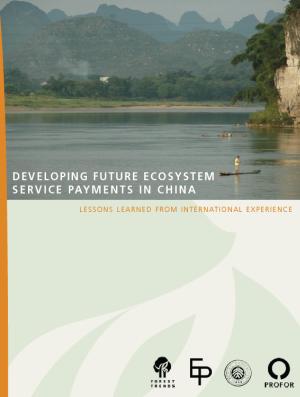
Share
Related Links
Keywords
Authors/Partners
Sara J. Scherr, Ecoagricultural Partners; Michael T. Bennett, Peking University; Molly Loughney and Kerstin Canby, Forest Trends.
Mobilizing Ecosystem Service Payments in China
CHALLENGE
Across the world, the growing scarcity of ecosystem services has led to a flurry of conservation innovations over the past decade in the form of payment schemes and nascent markets for these services. The global economic value of ecosystem services is estimated in the trillions of dollars, though actual payments for protecting these services are developing unevenly around the globe.
While Latin America has experimented extensively with diverse types of systems, developments in Asia and in Africa have lagged behind, although there is a large pipeline of projects ready to be initiated by international development banks and funds.
Against this global backdrop, the Chinese government made extraordinary efforts in driving some of the largest public payment schemes for ecosystem services in the world. As of 2005, over RMB 50 billion had already been spent on the Sloping Land Conversion Program, and 7.2 million ha of cropland enrolled. The government also spent RMB 2 billion annually on the Forest Ecosystem Compensation Fund, which in 2005 covered 26 million ha of forest area across 11 provinces in China.
Given concerns about the effectiveness and financial sustainability of these efforts, policy circles debated how to improve these programs as well as how to explore and develop other market-based tools and regulatory innovations to better address China's environmental and development challenges.
APPROACH
To inform this growing debate, PROFOR supported the development of a report entitled "Developing Future Ecosystem Service Payments in China: Lessons Learned from International Experience". The China Council on International Cooperation on Environment and Development (CCICED) Eco-compensation Taskforce asked Forest Trends to develop this report as a summary of the global experience in payments for ecosystem services (PES), emphasizing lessons of particular relevance to China.
MAIN FINDINGS
The key issues regarding the effectiveness and efficiency of PES programs are: the importance of policy, institutional and legal frameworks; improving the poverty reduction impacts of PES by engaging local communities in the process of negotiation, design and implementation; devising methods to improve targeting; and the need to engage the private sector in order to better capture the value of ecosystem services and to improve the financial sustainability of current and future PES programs by relieving the burden on public funds.
International experience also suggests that by bringing in local communities and governments more closely into all aspects and stages of PES design and implementation, China will be able to significantly improve equity and efficiency issues in current and future PES schemes, and work toward reconciling the dual goals of conservation and sustainable rural development.
For stories and updates on related activities, follow us on twitter and facebook , or subscribe to our mailing list for regular updates.
Author : Sara J. Scherr, Ecoagricultural Partners; Michael T. Bennett, Peking University; Molly Loughney and Kerstin Canby, Forest Trends.
Last Updated : 06-16-2024








